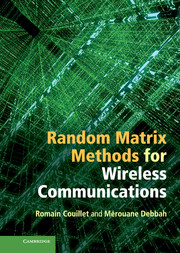Book contents
- Frontmatter
- Contents
- Preface
- Acknowledgments
- Acronyms
- Notation
- 1 Introduction
- Part I Theoretical aspects
- Part II Applications to wireless communications
- 11 Introduction to applications in telecommunications
- 12 System performance of CDMA technologies
- 13 Performance of multiple antenna systems
- 14 Rate performance in multiple access and broadcast channels
- 15 Performance of multi-cellular and relay networks
- 16 Detection
- 17 Estimation
- 18 System modeling
- 19 Perspectives
- 20 Conclusion
- References
- Index
19 - Perspectives
from Part II - Applications to wireless communications
Published online by Cambridge University Press: 07 October 2011
- Frontmatter
- Contents
- Preface
- Acknowledgments
- Acronyms
- Notation
- 1 Introduction
- Part I Theoretical aspects
- Part II Applications to wireless communications
- 11 Introduction to applications in telecommunications
- 12 System performance of CDMA technologies
- 13 Performance of multiple antenna systems
- 14 Rate performance in multiple access and broadcast channels
- 15 Performance of multi-cellular and relay networks
- 16 Detection
- 17 Estimation
- 18 System modeling
- 19 Perspectives
- 20 Conclusion
- References
- Index
Summary
Before concluding this book, we will briefly discuss open questions in random matrix theory. We will describe current research topics, results that are still unknown and that would be worth looking into. We also introduce briefly the replica methods, an alternative to the Stieltjes transform, and free probability methods proposed in this book which have been gaining a lot of interest lately, and will conclude with possible extensions of random matrix theory to a more elaborate time-varying (stochastic) mathematical framework.
From asymptotic results to finite dimensional studies
First, we recall the recent advances in random matrix theory, already introduced in this book, and which will be studied further in the near future. In Part I, we first explored limiting spectral distributions of some simple random matrix models. For instance, we characterized the l.s.d. of the sample covariance matrix model when the e.s.d. of the population covariance matrix converges weakly to some distribution function. We then observed that, for more practical system models, such as the sum of matrices with independent entries and left- and right-correlations, there may not exist a limiting spectral distribution, even when all deterministic matrices in the model do have a l.s.d. This led us to consider the deterministic equivalent approach instead of the l.s.d. approach. These deterministic equivalents have an outstanding advantage over l.s.d. and can be considered a major breakthrough for applied random matrix theory for the following reasons.
- Type
- Chapter
- Information
- Random Matrix Methods for Wireless Communications , pp. 501 - 510Publisher: Cambridge University PressPrint publication year: 2011



